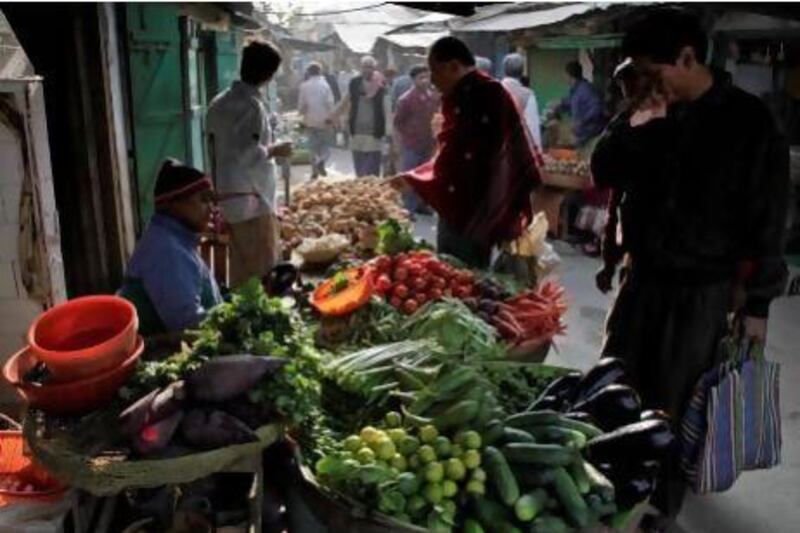NEW DELHI // Sunita Arora looked at a cart full of wilted, insect-eaten tomatoes and tried to bargain for a lower price.
The price per kilogram of tomatoes has nearly doubled in the past week from 22.40 rupees (Dh1.38) at the end of last month to 40 rupees (Dh2.47) at the Okhla vegetable and fruit wholesale market where Ms Arora was shopping in New Delhi.
The rising prices, a result of unseasonably heavy rains, are squeezing even middle class consumers like Ms Arora.
Across parts of northern India, an early and intense monsoon that many hoped would yield a bumper crop has instead damaged produce, pushing prices rises of vegetables into an even higher hemisphere.
"We are not poor. We have a decent middle class income. I should be able to afford at least tomatoes," she said. "Every week I worry about what to put on the table."
Ms Arora's husband, a retired postmaster, receives a pension of 500 rupees a month. The pension is supplemented by additional income from renting a portion of their house and from maturing mutual funds.
To stretch her monthly budget, she goes to the wholesale market three times a week at 7.30am to get "the most discounted rate possible".
At retail locations, customers are expected to pay at least 10 to 20 rupees on top of the wholesale price.
Government data released last month showed food inflation at 8.25 per cent, up from 6.08 per cent in May. This was before the monsoon rains came on June 1.
The heavy rain has washed away roads and farmland so less produce has been able to reach the market and that steep shortfall has led to prices skyrocketing.
India received its heaviest rainfall in 12 years last month, at 216.3 millimetres, according to India's meteorological department, and the monsoon season is only just beginning; rains are expected to continue through September.
At first, the early rains raised hopes of a bountiful harvest that would help curb already rising food prices.
Instead, it has been disastrous for farmers.
The south-west monsoon advanced at the fastest rate in more than 50 years, covering the country a month earlier than expected, according to the meteorological department.
A cloudburst two weeks ago over the northern state of Uttarakhand unleashed an avalanche of water that washed away hundreds of farms, roads and bridges, and displaced tens of thousands.
At least 1,000 are still missing, according to the state government. With the destruction of roads, the lorries that ferry perishable goods to the capital have been unable to get through, said Suresh Kumar Arora, the proprietor of a wholesale vegetable shop in Okhla where Ms Arora, who is not related, shops.
"There are no fields left to harvest. There are no roads to travel on. There is only a growing demand and limited supply," he said.
In Himachal Pradesh, the rains destroyed apple crops. In Haryana, the flood waters washed away farms on the banks of the river Yamuna.
Indian staples are in particularly short supply. The prices of lady's fingers, bitter gourd, white bottle gourd, cabbage, cucumber and tomatoes have doubled or tripled in the past two weeks.
Traders are struggling to keep prices as low as possible, said Kasim Malik, the president of the Okhla Wholesale Commission Agents Welfare Association, which represents traders such as Mr Arora.
They have to raise prices to maintain revenues, but are wary of driving customers away, he said.
"We are constantly watching the rivers. If their levels rise, we are going to be in trouble for the next few months," said Mr Malik.
He said he expected more heavy rains could disrupt supply for at least two to three months.
If the pace of the monsoon continues it will affect sowing for the next season of crops, which are planted in the middle of the monsoon season between now and next month, according to Parshuram Ray, director of the Delhi-based Centre for Environment and Food Security.
"It is a bit premature to predict what more damage we will see, but the problem has started," he said. "Another cycle could be destroyed adding more cause for worry."
There are other, "bigger indicators" that could also cause food prices to rise, Mr Ray said.
Those include the recent hikes in fuel prices. On Friday, India doubled the price of natural gas, which is used as cooking fuel.
The state-owned Indian Oil corporation raised petrol prices by 3.3 per cent on Tuesday, with a 1.2 per cent increase in diesel prices. In Delhi, a litre of diesel will now cost 50.84 rupees (3.13Dh).
"There is no way there is going to be respite for the common man," Mr Ray said. "The rise in the cost of transportation will only add on to the mess we are seeing."
[ sbhattacharya@thenational.ae ]
twitter: For breaking news from the Gulf, the Middle East and around the globe follow The National World. Follow us





